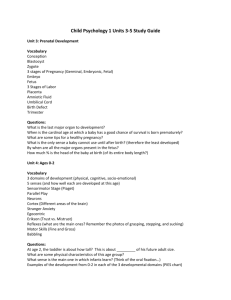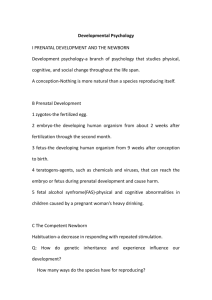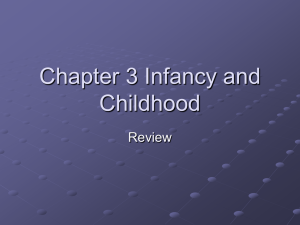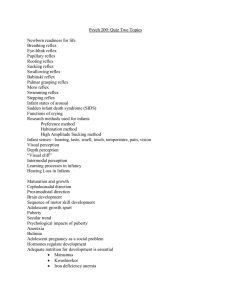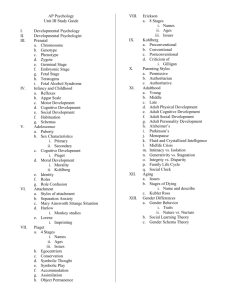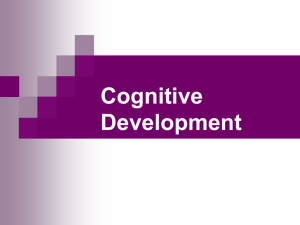AP_review_ppt3
advertisement
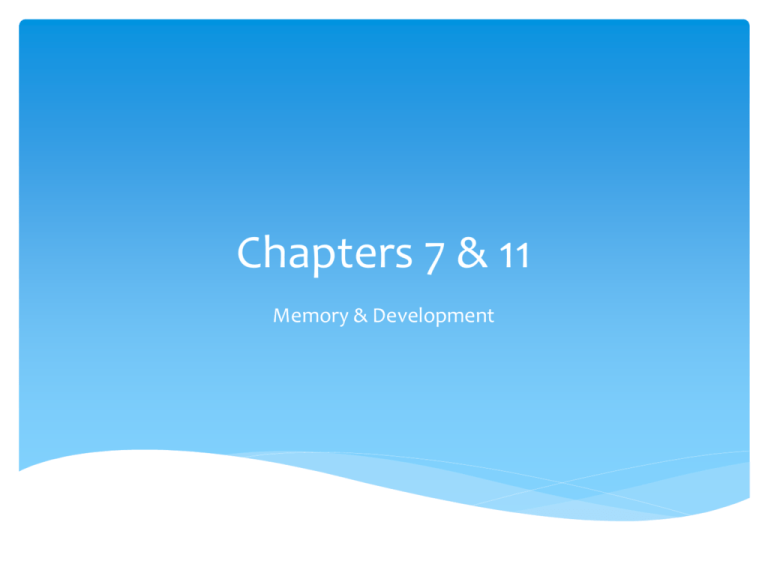
Chapters 7 & 11 Memory & Development Memory - Terms Encoding - forming memory code How something sounds, looks, what it means Storage - maintaining encoded info in memory over time Retrieval - Recovering info from memory stores Tip-of-The-Tongue Phenomenon - ability to remember something you know, accompanied by a feeling that it’s just out of reach Memory Terms Recall – Remember without cue Example: Fill in the blank, essay Recognition – Select from a list Example: MC questions, matching Serial-Position Effect - remember the first few and last few words in a list Recency effect – remember last things Primacy effect – remember first thing Memory Terms Clustering - Remember similar or related items in groups Sensory Memory - Preserves info in its original sensory form for a brief time, usually only a fraction of a second Example: Afterimage (sparklers) Iconic Echoic Memory Terms Short Term Memory (Working Memory) limited-capacity store that can maintain unrehearsed info up to 20 seconds Maintenance Rehearsal – Keeps in STM for longer period of time Memory Terms Elaborate Rehearsal Organizing and associating material with information you already have Memory Terms Long Term Memory Unlimited capacity store that can hold info for lengthy period Nondeclarative or procedural memory system – memory for actions, operations, conditioned responses Example – riding a bike, typing, tying a shoe Memory Terms Episodic Memory System – Chronological, temporally dated, personal experiences (autobiographical) Example – when did you see them, hear them – Metallica Semantic Memory System – general knowledge not tied to time it was learned (encyclopedia) Example – Christmas is on December 25th Memory Terms Flashbulb memories (270) - unusually vivid/detailed recollection of event Usually not as accurate as once believed Example: 9/11 Atkinson-Shiffrin 3 Stage Model of Memory Functional Fixedness Obstacle to problem solving only see things for what they are. MacGyver – does not suffer from this http://www.youtube.com/watch?v=ksgaup4zqz0 Development Life-Span Approach Life-Span Psychologists & Child Psychologist Although both study development, the child psychologist has decided to focus on a particular earlier portion of the typical life span. The view that development occurs across an entire lifetime was Erik Erikson Research Methods Normative Development Typical sequence of developmental changes for a group of people Example: Stage theory, individual development, or individual pattern of development, including differences among individuals during development Cross-Sectional Method investigators compare groups of participants of differing age at a single point in time Completed quicker and cheap Research Methods Longitudinal Method observe one group of participants repeatedly over a period of time Longer more money Developmental Issues Nature-Nurture debate Maturationists Emphasize role of genetically programmed growth & development on the body and nervous system Maturation – biological readiness Greater preprogrammed physiological development of the brain allows for more complex conceptualization and reasoning Developmental Issues Environmentalists John Lock’s – “Tabula rasa” or “Blank Slate” All development due to learning Continuous or Discontinuous (gradual/stage) development? Critical period Time which skill must be developed Feral children Friday! (that’s for you Cook) Developmental Issues Culture Collectivists – society over individual Individualist – personal over society Physical Development Prenatal period – extends from conception to birth usually encompassing nine months of pregnancy Germinal Stage first phase of prenatal development first two weeks after conception Zygote – cell division, expanding to sixty-four cells implants on uterine wall Physical Development Embryonic Stage – second stage of prenatal stage lasts two weeks to end of second month Most vital organs form Begin to look human Problems: Most miss carriages occur during this period, most birth defects develop during this stage Physical Development Fetal Stage – third stage of prenatal development last from 2 months to birth Physical movements due to skeletal structure hardening Sex organs develop around 3rd month Layer of fat develop Age of viability – age when baby can survive in the event of premature birth 22 – 26 weeks Physical Development Teratogens Harmful environmental agents that may effect fetal development Example: alcohol Fetal alcohol syndrome (FAS) Physical abnormalities & cognitive deficiencies Physical Development Reflex Neonate Newborn baby Sucking reflex Touch roof of baby’s mouth she will suck Palmer Reflex (Grasping reflex) Put finger in baby’s palm and baby will grab Babinski Reflex Stroke outer sole and baby spreads toes, stroke inner sole and baby curls toes Physical Development Reflex Head-turning reflex (rooting reflex) Elicited touching babies cheek Moro Reflex When startled, baby will throw arms and legs out and head back and then pull them into body Orienting Reflex Child orients themselves to their surroundings Example: loud crash, they will try and locate Physical Development Reflex Stereotyped Ingestive Responses Sucking, smacking of lips if a drop of sugar water is in their mouths Piaget Cognitive Development Jean Piaget Equilibration – child’s attempt to reach a balance between what the child encounters in the environment and what cognitive structures the child brings to the situation Piaget Cognitive Development Assimilation - interpreting new experiences in terms of existing mental structures without them changing Example: Four-legged pet = puppies same as they see cat = puppies Schema Mental representational model Accommodation – changing existing mental structures to explain new experiences Example: Puppies and cats are different Piaget’s 4 Stages Stage 1: Sensorimotor Period Coordination of sensory input and motor responses; development of object permanence Object permanence develops when a child recognizes that objects continue to exist even when they are no longer visible . . . Peek-a-Boo Example: hiding things under a pillow still exist Age: Birth – 2 years Piaget’s Stages Stage 2: Preoperational Period Improvement in mental images Conservation – awareness that physical quantities remain constant in spite of changes in their shape or appearance Example: Beaker of water experiment Centration – focus on just one feature of a problem, neglecting other important aspects Irreversibility – inability to envision reversing an action Example: preoperational children can’t mentally “undo” something Egocentrism – limited ability to share another persons viewpoint Example: preoperational children fail to appreciate that there are points of view other than their own Animism – belief that all things are living Example: children attribute lifelike human qualities to inanimate objects Age: 2 – 7 years Piaget’s Stages Stage 3: Concrete Operational Period Children can perform operation on images of tangible objects and actual events. There are several ways to look at a problem, now that they can undo something (conservation skills). Decline in egocentrism Age: 7 to 11 years Piaget’s Stages Stage 4: Formal Operational Period Mental operations applied to abstract ideas; logical, systematic thinking Metacognition – ability to recognize one’s cognitive processes and change/adapt those processes if not successful Idea of love, free will, justice Example: Think problems through before answering unlike a child that attacks on a problem quickly Age: 11 – adulthood Lev Vygotsky Believed that Piaget ignored the role of culture on cognitive development Cognitive development = active internalization of problem-solving processes as a result of interaction with others Ie, learning is ACTIVE, SOCIAL, and CREATIVE (ASC, sound familiar?) Children learn how to think through their interactions with others Where Piaget saw the child as a scientist, Vygotsky saw the child as an apprentice Fluid/Crystallized Intelligence Fluid Think in terms of abstract concepts/symbolic relationships Decrease with adulthood Crystallized Specific knowledge of facts, and information Erik Erikson tug of war that determined the subsequent balance between opposing polarities in personality: Erik Erikson Trust v. Mistrust – What happens: infant depends on adults for care and needs Age: birth to 1 Outcomes: Taken care of - optimism, trust Not taken care of –distrust, pessimism Autonomy v. Shame & Doubt – What happens: Toilet training and regulating behavior, child must take some responsibility Age: 2 – 3 Outcomes: Goes well – child becomes self-sufficient Conflict – personal shame or self-doubt Erik Erikson Initiative v. Guilt – What happens: Children experiment take initiatives may create conflict in house Age: 3 -6 Outcomes: Goes well – Child will respect others and parents wishes Conflict – Over controlling parents instill guilt and self-esteem issues Industry v. Inferiority – What happens: Functioning in society (outside of the house) Age: 6 – puberty Outcomes: Should lean to value achievement and take pride in accomplishments Erik Erikson Intimacy v. Isolation What happens: Share intimacy Age: Early adulthood Outcomes: Good – empathy and openness Bad – shrewdness and manipulative Generativity v. Stagnation (Self-Absorption) What happens: Concern for future generations, providing unselfish guidance to young Integrity v. Despair What happens: avoid dwelling on mistakes and death and find meaning in life Harry Harlow Monkeys need comfort/security as much as food Monkey loves soft mother rather than wire monkey Attachment – tendency to prefer specific familiar individuals over others Mary Ainsworth Strange situation – parent leaves child with stranger and returns Secure – child uses parent as support (most common) Insecure – Child does not know if parent will be supportive thus acts erratically (affects 7 – 15% of pop.) Avoidant – does not use parent for support, rear, usually abusive parents 3 Types of Parenting Style Authoritarian Follow rules or else Corporal punishment (spanking) for disobedience Authoritative Compliance to rules, however democratic Parent sets limits, punishments, forgives Permissive Few expectations, warm and non-demanding Not punished often Kohlberg’s Stage Theory Level 1: Preconventional Morality Stage 1 – Obedience & Punishment Rules are fixed absolute Obey rules = avoid punishment Stage 2 – Individualism & Exchange Serve ones own interests Heinz dilemma – best serve own need Kohlberg’s Stage Theory Level 2: Conventional Morality Stage 3 – Interpersonal Relationships Good boy – good girl living up to social expectations and roles Conformity Choices influence relationships Stage 4 – Maintaining Social Order Consider society as a whole when making judgments Follow rules and respecting authority Kohlberg’s Stage Theory Level 3: Postconventional Morality Stage 5 – Social Contract & Individual Rights Account for others opinions & values Rules of laws are important for society, but they must be agreed upon Stage 6 – Universal Principles Ethics and abstract reasoning People follow their personal principles of justice even if they conflict with laws/rules Elisabeth Kubler-Ross Stages of Death Denial, anger, bargaining, depression, and acceptance Freud Oral Stage Anal Stage Phallic Stage Oedipal Electra Latency Stage Genital Stage

